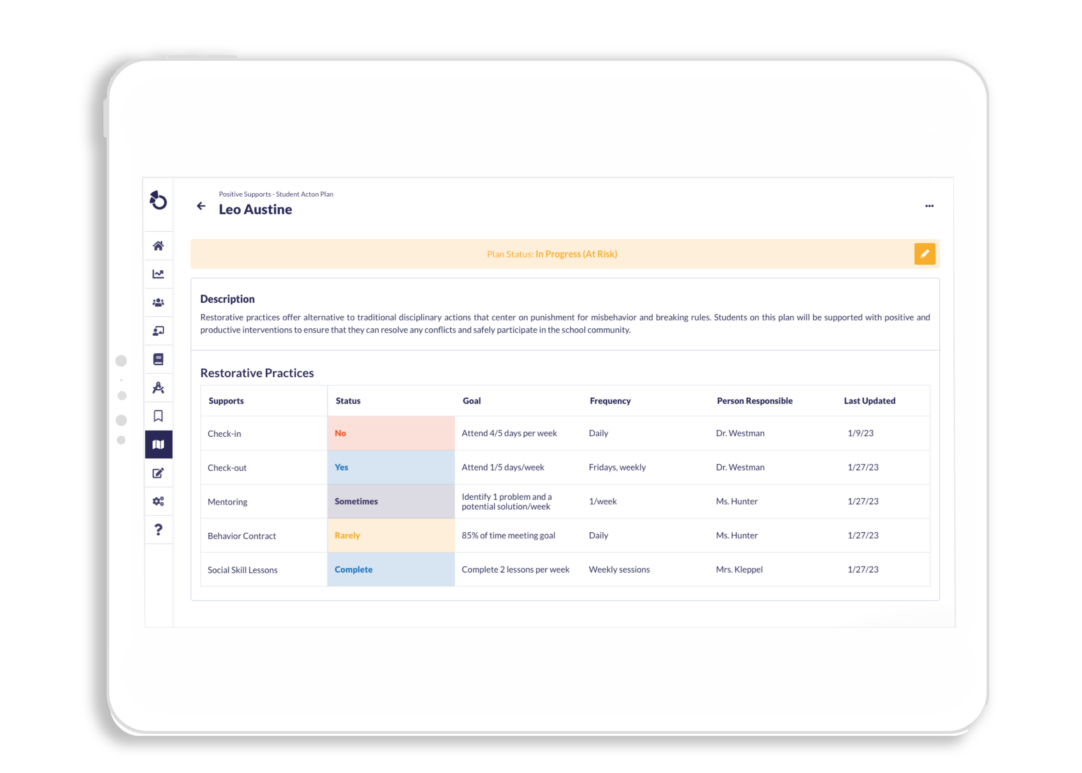How to Build, Maintain and Restore Teacher-Student Relationships
Restorative practices are focused on strengthening relationships between individuals as well as social connections within the school community.
There are five long-standing principles of restorative practices, known as the 5 R’s and these include:
- Relationship
- Respect
- Responsibility
- Repair
- Reintegration
In this webinar, Dr. Parker addresses the misconception that restorative practices do not hold students accountable, while sharing tangible ways educators can build relationships to reduce disruptive behaviors that often result in punitive consequences.
All of Dr. Parker’s solutions are rooted in the belief that restorative practices should be non-punitive, relationship-focused, address conflict, and promote problem-solving among staff and students.
Three Key Takeaways from Dr. Parker
- Building relationships is a mindset
In order to help students be more successful in school and life, there are two major things educators can do differently to better serve students – and that includes building relationships and restorative conversations. After implementing these two strategies with students, Dr. Parker discusses the incredible shift he saw in the data including a reduction in suspensions and office discipline referrals, and an 89-94% increase in attendance.
Schools must provide a safe and supportive environment that is conducive to learning for all students. However, when disruptive behaviors are present in the classroom, it poses a challenge to teachers and the positive environment they are working so hard to cultivate. The reality is that disruptive behavior will come up in the classroom but Dr. Parker asks educators to consider two critical questions on the topic: “How can we hold a high standard of behavior for our students and create prosocial behaviors? And if we do need to punish the behavior, how do we do so without punishing the child?” He says that building relationships is the solution.
“Building relationships with students is a mindset. It’s more about the mindset than the policies you have.” He emphasizes that educators cannot take disrespect personally. When Dr. Parker was a school leader, he gave every teacher a q-tip at the beginning of the school year as a reminder to ‘Quit Taking It Personally’ – because “you can only be successful at building relationships when you don’t take disrespect personally!”
- Restorative conversations make a difference
A second way to better serve students so they can be successful in both school and life is with restorative conversations. These conversations can be among two students involved in a conflict or between a teacher and student. In the latter example, if a teacher and student are not interacting positively, it can result in a student being removed from class – which does not lead to academic success.
Below are six restorative questions that can be used to guide a restorative conversation.
- What happened?
- What were you thinking at the time?
- What have you thought about since?
- Who has been affected by what you have done?
- In what way have they been affected?
- What do you think you need to do to make things right?
Dr. Parker shares two ways that these questions can be used with students. “You can have them come down to your office and answer questions verbally, or have the student sit right there and write their responses to the question on a printed form, that way they can think more critically about their responses, [which] gives the student time to self reflect on the harm they’ve caused and what they can do differently to make things right.”
Through restorative conversations, everyone involved has the opportunity to identify the root of the problem and take responsibility for their part, while also identifying what they need to do differently.
Following a restorative conversation, an educator may realize that a student needs support beyond what is currently being offered in the general education setting. If that’s the case, it’s important that schools have plans in place to provide what every student needs to be successful. Examples of restorative support include mentoring, check-in and/or check-out with a preferred teacher, social skills lessons and more. With Otus, educators can create custom student support plans that enable all stakeholders to track and visualize restorative supports that are being implemented. Below is an example of a Restorative Plan in Otus.

As teachers or administrators track a student’s progress on these restorative supports, they can drill down into specific goals to analyze progress over time. This total visibility into student support ensures that the data and evidence drives any future decisions.

- Praise to promote positive behavior
When students show up in our classroom, we need to support the whole child – not just their academic needs but also social emotional needs. Eighty percent of students will experience at least one adverse challenge by age 18 that can cause unwanted behavior in the classroom. One way we can proactively reduce unwanted behavior is with positive praise. Dr. Parker encourages educators to remember that “what gets praised gets done and gets done repeatedly. If we want to promote positive behavior we have to remember to praise them, because it’s so often that we focus on the negatives of our students; we really need to focus on the positives as well.”
In addition to praising students and providing feedback, educators need to create a safe space where students can openly communicate with their teachers and peers. Dr. Parker utilizes peace circles to promote these interactions in the school setting. Peace circles are a proactive way to prevent issues and solve behavior and discipline issues without punishing the child.
In a peace circle, students and school staff members sit together and take turns sharing their thoughts and concerns. When a participant wants to talk, they hold a meaningful object called a talking piece, and only the person holding it can speak at that time. This allows each participant to share openly without being interrupted or challenged by others.
According to a study by Chicago educator Sharon M. Ponder, “Restorative peace circles are designed to provide students, staff, community members and law enforcement official’s opportunities to analyze and discuss their issues and or concerns in a safe space. A peace circle is a restorative justice model that, like other restorative justice practices, can be used to address conflict holistically and solve problems. Peace circles emphasize healing and learning through a collective group process, aiming to repair harm done and assign responsibility by talking through the problem.”
“Peace circles emphasize healing and learning through a collective group process, aiming to repair harm done and assign responsibility by talking through the problem.”
Sharon M. Ponder, Chicago public schools
Because peace circles are restorative in nature, they lower the frequency of negative behaviors. Research from Yale National Initiative shows that in Minneapolis, MN, peace circles, conferences and mediation were researched and office referrals and suspensions were decreased by 48 – 63%. Dr. Parker points out that it’s important to acknowledge that we can’t eliminate negative behaviors entirely but we can implement processes that reduce the behaviors and keeps students in the learning environment.
Ready to learn more about how Otus can support progress monitoring in your school community? Get in touch with our team!
